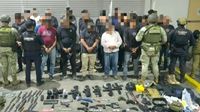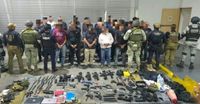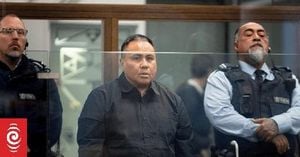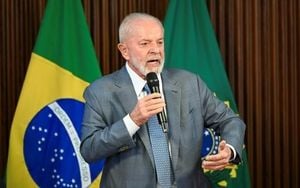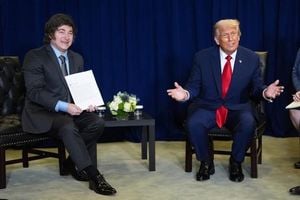At dawn on September 24, 2025, a heavily armed security operation swept into a remote plot of land in Vista Hermosa, Michoacán, Mexico. Authorities, bracing for a confrontation with cartel members, instead encountered a scene that left even seasoned officers puzzled: 38 men clad in tactical gear, identifying themselves not as drug traffickers, but as members of the evangelical church La Luz del Mundo (The Light of the World). The men claimed they were training to serve as the Jahzer Guard, a special protective corps for the church’s embattled leader, Naasón Joaquín García, and his immediate family.
According to EL PAÍS, the operation—initially believed to be targeting organized crime—exposed a web of religious zeal, paramilitary discipline, and allegations of criminal activity that has since gripped both Mexican and U.S. media. The detainees, hailing from across Mexico and including a U.S. citizen, were reportedly preparing for roles that went far beyond spiritual guardianship. Their stated mission: to shield García, who is currently jailed in Chino, California, and recently indicted in New York on charges of racketeering and sex trafficking, as well as to protect his family and the broader interests of the church.
The surprise did not end with their religious affiliation. As Los Angeles Press reports, the facility itself was identified by locals as being linked to the Cartel Jalisco Nueva Generación (CJNG), a powerful drug trafficking organization recently designated as a terrorist group by several governments. The property’s reputation and the cache of seized equipment—including replica firearms, a box designed to simulate a homemade bomb, tactical helmets, backpacks, army insignias, and even computers—suggested a more sinister purpose. Among the arsenal, authorities also found a real nine-millimeter handgun with ammunition, five knives, and a vehicle. The men’s attire—mostly black T-shirts and jeans—stood in stark contrast to the military-style organization on display.
Sharim Guzmán, a survivor of abuse within the church and a vocal whistleblower, told EL PAÍS that the guards’ duties extended well beyond mere protection. "When a problem arises, they solve it. At first, it was protecting the apostle, like his bodyguards, but with Naasón’s arrest, they’ve gone crazy. They don’t know how to control the problem, so they’ve started tracking down and hiding the victims, to keep them from speaking out," Guzmán recounted. He further alleged that these guards, some of whom are former law enforcement officers or soldiers, have also engaged in criminal activities such as kidnapping and detaining victims—especially women—in safe houses.
The origins of the Jahzer Guard stretch back to an earlier era, when Naasón’s father, Samuel Joaquín, established the Jericho Guard as a praetorian force for the church leadership. Photographs obtained by EL PAÍS even show a young Naasón participating in these groups, highlighting how the normalization of militarized security has been woven into the church’s culture from an early age. Boys in the congregation, Guzmán explained, are invited to join martial arts training groups, taught that the church is always under threat and that unwavering protection of the apostle is a sacred duty. "We were always told that La Luz del Mundo was the church of God and that everyone would want to harm the apostle, like Jesus, and that’s why he had to be guarded and protected. So you normalized it. Obviously, you never questioned the fact that those guards were armed," he said.
The detainees reflected the church’s far-reaching influence, coming from Nayarit (18), Guadalajara (6), Mexico City (3), Michoacán (2), and a smattering of other states, as well as one U.S. citizen. According to EL PAÍS, a man from Colombia managed to escape during the operation, raising fresh concerns about the involvement of foreign nationals and the cross-border nature of the church’s security apparatus. President Claudia Sheinbaum’s administration has previously tracked links between former Colombian soldiers and Mexican criminal groups, and the presence of a Colombian fugitive may point to broader regional entanglements.
Videos posted online by local reporters showed the group, including several teenagers with boyish faces, arriving at the Attorney General’s Office in Morelia. Their demeanor was described as unusually calm given the circumstances. The youngest among them, according to Security Secretary Juan Carlos Oseguera Cortés, were just teenagers. Notably, the arsenal found at the site included a mix of real and replica weapons: five replica long guns, 14 replica handguns, 22 dummy knives, and a host of tactical gear. Authorities also seized computers and notebooks, though Oseguera Cortés declined to reveal details about their contents, citing the ongoing investigation.
The site’s location in what locals call "deep territory" of the CJNG has only heightened suspicions about possible connections between the church and criminal organizations. While no official statement has clarified the ownership of the property, the overlap between religious, paramilitary, and criminal elements has fueled speculation. Los Angeles Press points out that the arrest came just days after new U.S. charges were announced against García, and that the event echoes earlier discoveries of cartel-linked training camps in neighboring Jalisco, including the infamous Rancho Izaguirre. That facility, discovered in 2024, was reportedly used for human trafficking and the disposal of bodies, though official investigations have been slow and plagued by conflicting accounts.
The Mexican government’s response has been notably muted. As Los Angeles Press observes, authorities have provided only the barest of official statements, with Oseguera Cortés confirming that the facility and detainees are now under the custody of Mexico’s Attorney General’s Office (FGR). This strategic silence, some analysts suggest, reflects the volatility of the situation and the government’s desire to avoid inflaming tensions or drawing unwanted attention to potentially explosive links between religious organizations and organized crime.
Meanwhile, the Luz del Mundo Church continues to wield significant cultural and political power, particularly in its stronghold of Hermosa Provincia in Guadalajara. Despite mounting allegations—from sexual abuse to human trafficking—Mexican authorities have yet to launch comprehensive investigations into the church or its leaders. This stands in stark contrast to the legal actions pursued in the United States, where García faces a growing list of charges. The lack of official scrutiny in Mexico has drawn criticism from survivors and watchdog groups, who argue that impunity persists for powerful religious figures accused of grave crimes.
As the investigation unfolds, the events in Vista Hermosa have cast a harsh spotlight on the shadowy intersections of faith, security, and criminality in Mexico. The discovery of a paramilitary guard loyal to a jailed religious leader, training in territory associated with one of the world’s most dangerous cartels, raises unsettling questions about the reach of both the church and organized crime. For now, the fate of the 38 detainees—and the secrets contained in their seized computers and notebooks—remains in the hands of federal prosecutors, as the nation watches and waits for answers.
